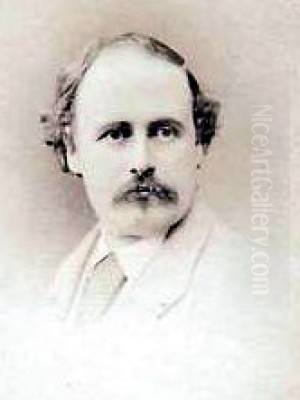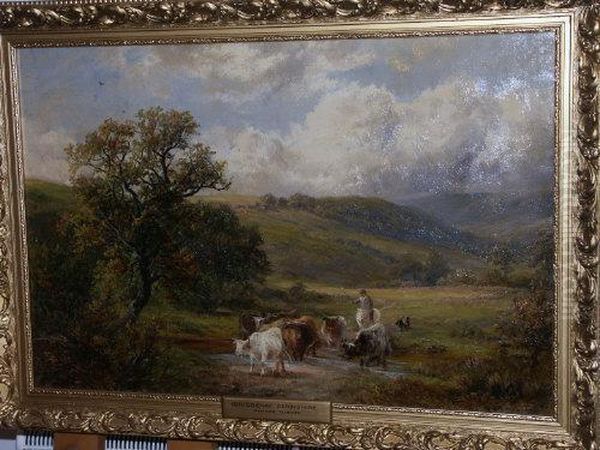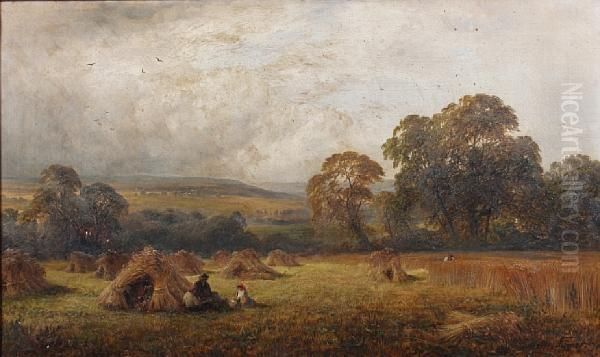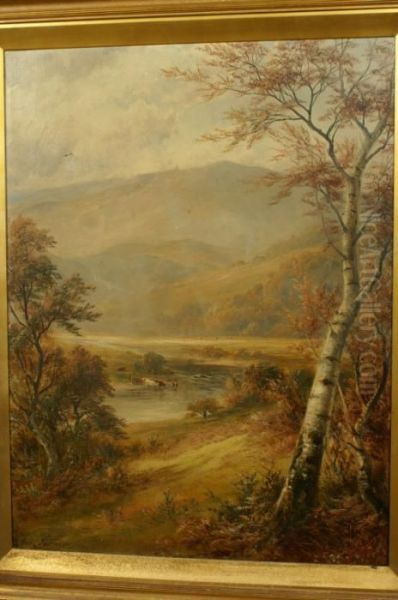
George Turner, born in 1843 and passing away in 1910, stands as a significant figure in the tradition of English landscape painting, particularly celebrated for his evocative depictions of his native Derbyshire. Often affectionately nicknamed "Derbyshire's John Constable," Turner dedicated his artistic life to capturing the subtle beauties, rustic charm, and changing seasons of the county he called home. While sharing a name with the titan of Romanticism, Joseph Mallord William Turner (J.M.W. Turner), George Turner carved his own distinct niche, focusing on a more intimate, naturalistic portrayal of the English countryside, earning him lasting recognition within his region and among connoisseurs of traditional landscape art.
Early Life and Artistic Awakening in Derbyshire
George Turner's journey began not in an established art academy, but amidst the landscapes he would come to paint. He was born in Cromford, Derbyshire, a village already steeped in industrial history but surrounded by compelling natural scenery. His family later relocated to the town of Derby, which would remain a central point in his life and career. From a young age, Turner displayed a dual aptitude for both music and the visual arts, suggesting an innate sensitivity to harmony and composition.
Crucially, his artistic inclinations found encouragement at home. His father, Thomas Turner, though sometimes described as a draper or tailor, recognized and nurtured his son's talent. This paternal support was vital, as George Turner did not follow a conventional path of formal art education. Instead, he embarked on a journey of self-discovery, learning to paint and draw through keen observation, dedicated practice, and likely, the study of works by other artists available to him. This self-taught background perhaps contributed to the freshness and directness often seen in his work.
The Path to Professional Artistry
Driven by his passion and honed skills, George Turner transitioned from an aspiring amateur to a professional painter. Alongside developing his own landscape practice, he also took on the role of an art teacher, sharing his knowledge and fostering talent in others within the Derbyshire community. This dual role as both creator and educator solidified his position within the local art scene.

His commitment was unwavering; Turner spent his entire life residing and working within Derbyshire. His focus remained predominantly on the southern parts of the county, an area characterized by rolling hills, meandering rivers, particularly the Trent, and picturesque villages. This deep, lifelong immersion in his subject matter allowed him to develop an intimate understanding of the land, its light, and its moods, which became the bedrock of his artistic output.
Derbyshire's John Constable: Style and Influences
The comparison to John Constable (1776-1837) is perhaps the most frequent and illuminating descriptor applied to George Turner. This moniker, "Derbyshire's John Constable," points to several key aspects of his style. Like Constable, Turner was deeply committed to painting directly from nature, or at least basing his studio work on meticulous outdoor studies. He sought to capture the authentic character of the English countryside, eschewing idealized classical landscapes for the familiar fields, trees, and waterways of his home county.
His work is characterized by a robust naturalism. Turner painted recognisable locations, often imbued with a sense of lived-in reality. His handling of light is often noted – he captured the specific atmospheric conditions of Derbyshire, from the bright sunshine of a summer harvest to the more muted light of autumn or the crisp air of winter. His colour palette, while perhaps not as radically experimental as Constable's later work, was noted for its vibrancy and truthfulness to the local scenery.
While Constable is the most cited influence, Turner worked within the broader context of 19th-century British landscape painting. Artists like David Cox (1783-1859) and Peter De Wint (1784-1849) had earlier championed a naturalistic approach to landscape, particularly in watercolour, which may have informed Turner's sensibilities. Furthermore, the enduring popularity of detailed, picturesque rural scenes among Victorian audiences provided a receptive environment for his art. He successfully blended topographical accuracy with a gentle, pastoral sentiment.
The Trent Valley and Rural Life: Favourite Subjects
George Turner's oeuvre is a love letter to the Derbyshire landscape. He repeatedly returned to certain favoured locations and themes. The River Trent and its surrounding valley were frequent subjects, with paintings often depicting tranquil stretches of water, lush riverbanks, and grazing cattle – a common motif adding life and scale to his scenes. Works like Trent Side, Barrow on Trent exemplify this focus, capturing the peaceful coexistence of agriculture and nature.

He painted the villages and hamlets of South Derbyshire, such as Barrow upon Trent, Twyford, Ingleby, and Knowle Hills. His canvases often feature charming stone cottages nestled amongst trees, farmsteads bustling with quiet activity, and winding country lanes. Figures are usually present but tend to be integrated into the landscape rather than dominating it – farm workers, families strolling, people tending livestock – reinforcing the theme of rural life lived in harmony with the natural environment.
Turner was also adept at capturing the changing seasons. His portfolio includes scenes of spring blossoms, summer haymaking and harvests, rich autumnal foliage, and snow-covered winter landscapes. This attention to seasonal specificity further grounds his work in the observable realities of the Derbyshire countryside, offering a comprehensive portrait of the rural year.
Notable Works and Representation
While a comprehensive catalogue remains elusive, several key works represent George Turner's style and subject matter. A Quiet Spot in South Derbyshire, held by Wolverhampton Art Gallery, showcases his ability to create a serene composition, likely depicting a familiar scene along the Trent or a tributary, imbued with calm light and careful detail.
Other representative titles that appear in auction records and collections include Trent Side, Barrow on Trent, Near Idridgehay, Derbyshire, Harvesting near Barrow-on-Trent, A View in Dovedale, On the Trent near Ingleby, and Winter Scene in Knowle Hills. These titles alone underscore his deep connection to specific Derbyshire locales. His paintings often feature his signature attention to the rendering of trees, water, and skies, combined with a solid compositional structure.
Today, George Turner's works are primarily found in the Derby Museum and Art Gallery, which holds a significant collection, and other regional UK museums like Wolverhampton. Many reside in private collections, particularly appreciated by those with a connection to Derbyshire or a fondness for traditional English landscape painting.
Exhibition Career and Local Recognition
George Turner sought and achieved recognition beyond his immediate locality during his lifetime. He exhibited his works at several prestigious venues, demonstrating his ambition and the quality of his output. Records show he exhibited paintings at the Royal Academy of Arts in London, albeit sparingly, indicating he met the standards of the nation's premier art institution.
More consistently, he supported regional exhibition societies. He frequently showed his work at the Royal Birmingham Society of Artists (RBSA), a key venue for artists in the Midlands. He also exhibited with the Royal Society of British Artists (RBA) in London. This consistent presence at respected exhibitions helped build his reputation during the 1880s and 1890s, a period often considered his peak.

His standing within the Derbyshire art community was further cemented by his involvement with local institutions. He served on the Art Committee of the Derby Art Gallery, contributing his expertise to the development of the town's public collection and art scene. This role signifies the respect he commanded among his peers and local patrons.
A Family Legacy: Teaching and Influence
Beyond his own prolific output, George Turner contributed to the continuation of landscape painting through his role as a teacher. While details of all his students are not widely documented, his most significant pupil was undoubtedly his own son, William Lakin Turner (1867-1936).
William Lakin Turner followed closely in his father's footsteps, also becoming a landscape painter with a focus on Derbyshire, as well as other scenic areas like the Lake District and Scotland. While developing his own style, William's work clearly shows the influence of his father's naturalism and dedication to capturing the specifics of place. The Turner name thus represents a multi-generational contribution to Derbyshire art. George Turner's influence extended through his teaching, helping to shape the skills of other aspiring artists in the region.
Contextualising Turner: Victorian Landscape Painting
George Turner worked during a period when landscape painting was immensely popular in Britain. The Victorian era saw a continued appreciation for the countryside, viewed variously as a place of picturesque beauty, moral virtue (in contrast to the industrialising cities), and national identity. Turner's art tapped into this sentiment, offering reassuring and skillfully rendered images of rural England.
His style can be situated within the mainstream of Victorian naturalism. Unlike the dramatic, often sublime, and increasingly abstract visions of J.M.W. Turner (1775-1851), George Turner's work remained grounded in careful observation and a more literal representation of scenery, aligning him more closely with the tradition of Constable. He did not engage with the detailed symbolism and moral intensity of the Pre-Raphaelite Brotherhood, who were also active during part of his career, nor the looser, more impressionistic techniques beginning to emerge from France.
Compared to some popular contemporaries known for grander, sometimes more formulaic, landscapes like Benjamin Williams Leader (1831-1923) or Alfred de Bréanski Sr. (1852-1928), Turner's work often feels more intimate and specific to his chosen locale. While perhaps less dramatic, his paintings possess a quiet authenticity and charm derived from his deep familiarity with Derbyshire. Other contemporaries exploring British landscape included artists like George Vicat Cole (1833-1893) and Henry John Boddington (1811-1865), each contributing to the rich tapestry of 19th-century landscape art.
Enduring Legacy and Appreciation
George Turner's legacy is primarily that of a dedicated and highly skilled regional painter. He may not have achieved the revolutionary status or international fame of J.M.W. Turner or John Constable, but his contribution to British art, and specifically to the artistic heritage of Derbyshire, is undeniable. His paintings endure as valuable records of the county's landscape and rural life in the late 19th and early 20th centuries, capturing scenes and ways of life that have since changed.
His work continues to be appreciated by collectors and enthusiasts of traditional British landscape painting. Auction results demonstrate a steady market for his works, particularly those depicting identifiable Derbyshire scenes in good condition. While perhaps overshadowed in broader art historical narratives by more innovative figures, his skill, dedication, and the sheer appeal of his gentle, naturalistic landscapes secure his place.
The nickname "Derbyshire's John Constable" remains a useful, if simplified, starting point for understanding his artistic aims and achievements. He successfully translated the principles of truth to nature, championed by Constable, to his beloved Derbyshire scenery, creating a body of work that is both aesthetically pleasing and historically significant for the region.
Conclusion: The Painter of Derbyshire
George Turner (1843-1910) devoted his life and art to the Derbyshire countryside. As a self-taught artist who rose to become a respected professional painter and teacher, he created an extensive body of work characterized by its naturalism, sensitivity to light and atmosphere, and deep affection for his native county. Often compared to John Constable, he captured the fields, rivers, villages, and changing seasons of Southern Derbyshire with skill and sincerity. Though his fame remained largely regional, his paintings endure as cherished depictions of a specific English landscape and a testament to a life spent in dedicated observation and artistic practice. His work remains a significant part of Derbyshire's cultural heritage and holds a secure place within the tradition of British landscape painting.